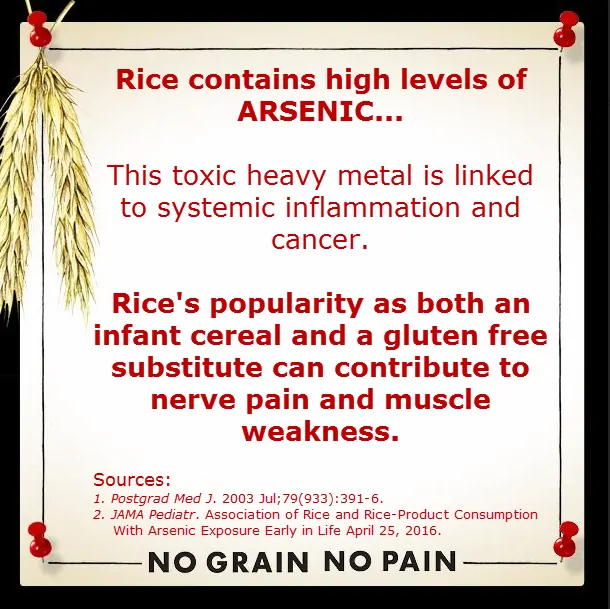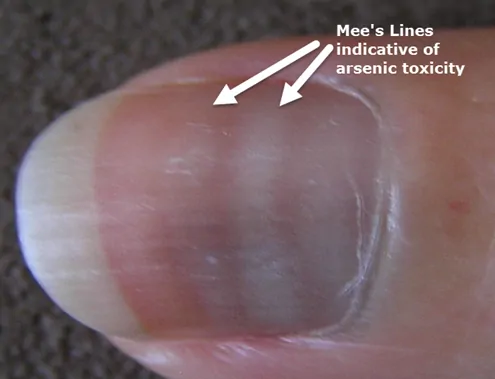Is a Gluten Free Diet Good for Type 2 Diabetes
Gluten Free Society Blog, No Grain No Pain
The Dangers of Eating Rice on a Gluten Free Diet
High Levels of Arsenic Found in Rice Threatens Those Following a Traditional Gluten-Free Diet Plan
Arsenic exposure and subsequent toxicity is a health problem affecting millions of people worldwide. Exposure to arsenic comes from several sources to include – well water (arsenic occurs naturally in some geological formations), contamination from mining and ore smelting, and from seafood (a less toxic organic form of arsenic). Arsenic can also be found in the following: grains (and grain-based products), bottled water, coffee, processed juice, and beer. According to an investigation from Consumer Health Reports, the highest levels of this toxic metal are found in rice (especially brown rice) and rice gluten.
Most gluten-free food is made from either corn or rice. Both of these have been found to have arsenic in them. Particularly the rice is the higher of the two. Often times people believe that they are eating really well when in reality they are being exposed to arsenic.
Gluten-Free Rice Products = More Arsenic Exposure = More Disease Risk
 Those going gluten-free initially tend to gravitate toward high levels of rice-based substitutes like bread, pasta, cereals, etc. due to their new gluten frees diet plan. If you aren't up to speed on rice gluten and the potential danger it poses to those with gluten sensitivity, I highly encourage you to watch this video.
Those going gluten-free initially tend to gravitate toward high levels of rice-based substitutes like bread, pasta, cereals, etc. due to their new gluten frees diet plan. If you aren't up to speed on rice gluten and the potential danger it poses to those with gluten sensitivity, I highly encourage you to watch this video.
Beyond the problem rice gluten may pose, this new research shows that rice-based foods contain levels of arsenic that can create a significant risk to your health.
Who is at the greatest risk?
- Infants – often times infants are fed excessive riced based cereals, formulas, and cracker products. Especially infants who tend to suffer from allergies to milk, soy, and corn. Even beyond the arsenic danger, many infants have severe reactions to rice products. This condition known as FPIES (food protein-induced enterocolitis) is a serious problem. You can read more about this in my book, No Grain No Pain on pages 183 and 184.
- Gluten-Free Newbies – These individuals are typically already very sick with autoimmune diseases and suffer from malnutrition. When going gluten-free initially, these are the people who rely largely on rice-based products. Because they are already sick, they are more susceptible to arsenic exposure especially if they have pre-existing liver or kidney issues.
Why Is Arsenic Dangerous?
Arsenic was popularized as a murder weapon in the movie Arsenic and Old Lace. It is tasteless, odorless, and looks like sugar crystals. In large enough doses, arsenic is deadly, though most of my experience deals with chronic low dose arsenic exposure creating chronic health issues. Let's differentiate the fact that arsenic comes in two flavors:
- Organic (arsenobetaine and arsenocholine) – these forms are relatively nontoxic and prominently found in seafood. They are excreted from the body via the kidneys.
- Inorganic arsenic (Trivalent or As III) – This form of arsenic is the real danger, and it is the form commonly found in rice-based products. It exerts damage by interfering with at least 200 different enzyme systems in the body. Many of these are critical in producing energy and regulating DNA. It is also a known human carcinogen (causes cancer). Chronic exposure to even low levels of arsenic can cause systemic multi-organ disease and damage including the liver, kidney, heart, lung, muscles, nervous system, and GI tract. Exposure to inorganic arsenic comes from rice (especially brown rice), contaminated drinking water, pesticides, insecticides, and fungicides. It is important to note that even organically grown rice can contain high levels of arsenic because it can be found at high levels in soil depending on where it is grown.
 Symptoms of Arsenic Poisoning – Many of the symptoms linked to arsenic exposure overlap the symptoms that gluten can cause. That's why it is important to know them, especially if you are one of the "gluten-free newbies" relying on heavy rice products as a staple in your diet. Symptoms included: neuropathy, epileptic seizures, cardiomyopathy (heart damage), abdominal pain, nausea, severe diarrhea, skin rashes, and white bands across the fingernails (Mee's lines – see picture on the right).
Symptoms of Arsenic Poisoning – Many of the symptoms linked to arsenic exposure overlap the symptoms that gluten can cause. That's why it is important to know them, especially if you are one of the "gluten-free newbies" relying on heavy rice products as a staple in your diet. Symptoms included: neuropathy, epileptic seizures, cardiomyopathy (heart damage), abdominal pain, nausea, severe diarrhea, skin rashes, and white bands across the fingernails (Mee's lines – see picture on the right).
Is Rice Is Gluten Free
Did you know that oftentimes people will purchase rice thinking that they are eating well? Even though rice is gluten-free you are still being exposed to arsenic. This is not a great alternative when you are trying to take care of your body. It can be most harmful to people with celiac disease and other harmful diseases.
How Is Arsenic Eliminated From The Body?
No universally agreed upon medical treatment exists for arsenic poisoning. It is important to understand that inorganic arsenic has to go through a methylation reaction in the liver before it is excreted by the kidneys. This means that those people who have genetic methylation problems are at greater risk for arsenic toxicity. It can also be deposited in hair, skin, and nail tissues. In my experience, it is important to support liver and kidney function in people with chronic arsenic exposure. Chelation can be performed, and there are a number of natural chelating agents that help bind toxic metals and remove them from the body. Let's start with some excellent food-based chelators. Garlic, cilantro, parsley, broccoli, and onion are all excellent options.
In my experience, there are some very effective natural agents in supplement form that can also be used. One of my favorites is high dose vitamin C (10 grams/day). N-Acetyl Cysteine (NAC), Alpha Lipoic Acid, and Chlorella are also good supplemental options. I will be going into more detail about chelation later this month. Stay tuned for more on this. In the meantime, I urge you to reconsider using rice as a major staple in your diet.
Always looking out for you,
Dr. Osborne – The Gluten Free Warrior
Does rice bother you? Chime in below and let us know…
Is a Gluten Free Diet Good for Type 2 Diabetes
Source: https://www.glutenfreesociety.org/dangers-eating-rice-gluten-free-diet/